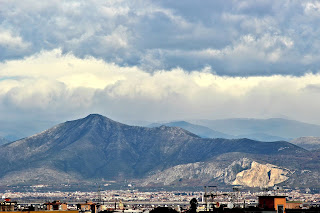One of the many curious features of the Tabula Peutingeriana is a depiction of Monte Tifata, a holy mountain in Campania, Italy. Tifata is a strong point, a ridge 600 metres high with steep slopes. From the top you get a view both ways along the Via Appia, and also to Vesuvius to the south and the River Volturno below (
Corryx, Wikipedia, 2016).
The Tabula depicts Tifata Mons with two notable temples and a sacred spring:
From left to right (west to east) these places are the Baths of Sulla, a Temple of Diana (Diana Tifatina) and a Temple of Jove (Iovis Tifatinus). The whole drawing seems to be fairly accurate, as it is now accepted that the temple to Diana was at the western foot of the mountain and its stone is probably incorporated within the walls of the splendid Benedictine basilica of Sant'Angelo in Formis. Note how the temple at right seems to be drawn in a perspective suggesting it is on a height.
Stefania Quilici Gigli hypothesizes that the Baths of Sulla were close by. Lucius Cornelius Sulla Felix (c. 138 BC – 78 BC) had won a victory at Caio Norbano near here on his 83 BC March on Rome. The Roman historian Velleius states that Sulla made a foundation of land and waters here to celebrate this, reading thus in the
Shipley translation:
It was while Sulla was ascending Mount Tifata that he had encountered Gaius Norbanus. After his victory over him he paid a vow of gratitude to Diana, to whom that region is sacred, and consecrated to the goddess the waters renowned for their salubrity and water to heal, as well as all the lands in the vicinity. The record of this pleasing act of piety is witnessed to this day by an inscription on the door of the temple, and a bronze tablet within the edifice.
This does not explicitly say there were baths, but
Stefania Quilici Gigli thinks nearby land-marker inscriptions of a later period refer to this land use and both custom and the Tabula would indicate the “waters” were utilized as baths. The purpose of bathing would have been healing rather than play.
The temple of Jove is thought to have been at the summit, near today’s illuminated cross, the Croce del Tifata:
A hiking trail to this is shown on an
Italian trails site, Sentieri dei Colli Tifatini.
Knowing all this, the illustrations in the Tabula are most interesting. The two pictures of temples are of a type, but with different fronts. One (Diana) shows a rose window in the front, the other (Jove) shows a high doorway, and I realize after seeing a picture of Sant'Angelo that this probably represents an arch added at the front:
The third image shows an expansive building of two storeys with a tower and a similar arched entrance at left. The usual Tabula icon for a baths lacks such a tower, so perhaps the extra element is a distinctive feature of the Tifata site.
As I note above, I am sceptical of the view (forever associated with the Levis) that baths on the Tabula denote places of recreation. I suggest the primary connotation of such buildings for pre-Christian readers was as ritual sites, and thus the focus would be on the magic rather than the purely pleasurable quality of the waters.











